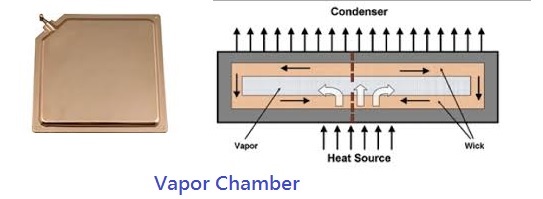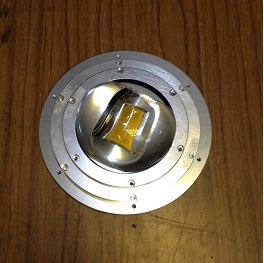What is “Vapor Chamber”
Vapor Chambers provide far superior thermal performance than traditional solid metal Heat spreaders at reduced weight and height. Thermal spread resistance is almost neglectable and thermal resistance is x times lower than (refer to copper, carbon nanotube compound, nano diamond compound). Vapor Chambers enable higher component heat densities and TDPs(Thermal Design Power) at safe operating temperatures, extending the components and products life.
How do Vapor Chambers work
As the coolant molecules are heated they change phases. The vaporized coolant convicts freely through the chamber. The Molecules then condense on cold surfaces, dissipate their heat load, and are channeled back to the coolant reservoir. Since the rate of condensation depends on the temperature delta of the coolant and the contact surface, the coolant automatically streams towards the coolest surface area. This self-organizing active molecular coolant stream within the Vapor Chamber is responsible for its superior thermal properties. As a result it provides stable and evenly spread temperatures on all of its surfaces, regardless of the location and density of the heat source below the chamber base.
 |
(MoriLite/LEDinside)
|
What is “Flip Chip”
Flip chip, also known as controlled collapse chip connection or its acronym, C4, is a method for interconnecting semiconductor devices, such as IC chips and micro electromechanical systems (MEMS), to external circuitry with solder bumps that have been deposited onto the chip pads. The solder bumps are deposited on the chip pads on the top side of the wafer during the final wafer processing step. In order to mount the chip to external circuitry (e.g., a circuit board or another chip or wafer), it is flipped over so that its top side faces down, and aligned so that its pads align with matching pads on the external circuit, and then the solder is reflowed to complete the interconnect. This is in contrast to wire bonding, in which the chip is mounted upright and wires are used to interconnect the chip pads to external circuitry.
 |
|
(MoriLite/LEDinside) |
What is C.O.B.
Chip-on-board, COB, is a technology where uncoated semiconductor elements (dice, die, chip) are mounted directly on a PCB or a substrate of e.g. glasfibre epoxy, typically FR4 and die bonded to pads of gold or aluminum.
 |
|
MoriLite COB Lights Engine. (MoriLite/LEDinside) |














